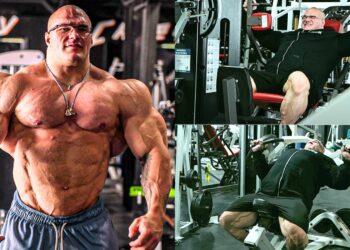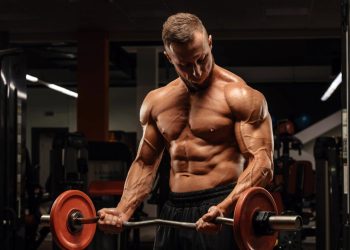The dumbbell incline row, also called the chest-supported row, is a back exercise variation that’ll add muscle and strength to your upper posterior chain (backside of the body).
In fact, research has shown that the bent-over row is superior for symmetrical activation of the back muscle compared to most other back exercises… we’re not making this up (1).
Therefore, we expect this variation to elicit similar results. But it also prevents training boredom, teaches you to check your ego at the door, and it takes a lot of potential stress from the back and hip extensors.
In this guide, we’ve explained how to do this exercise with tips, variations, and how to include it in your training.
Muscles Worked
The dumbbell incline row works the back and other muscles as well. Here are all of the muscles involved in this movement.
Infraspinatus
Infraspinatus is one of the four rotator cuff muscles that function to stabilize and support movement of the shoulder joint. It connects from the top of the upper arm bone to the shoulder blades.
Level Up Your Fitness: Join our 💪 strong community in Fitness Volt Newsletter. Get daily inspiration, expert-backed workouts, nutrition tips, the latest in strength sports, and the support you need to reach your goals. Subscribe for free!
Latissimus Dorsi
A large and powerful muscle that takes up most of the back, latissimus dorsi works best during exercises when the arms are overhead (e.g., pull-up, rock climbing). In addition to being a pull muscle, lats cooperate with teres major and pectoralis major to adduct (bring toward the midline of the body) and medially rotate the humerus.
Teres Major
The teres major is also a rotator cuff muscle that’s located on the underside of the upper arm near the teres minor. It helps to stabilize the upper portion of the humerus, medially rotate the humerus and works with the lats to move the humerus back and down when extended.
Teres Minor
Another rotator cuff muscle, the teres minor is the primary muscle surrounding the rotator cuff. It stabilizes the glenohumeral joint and is responsible for lateral or external rotation of the arm at the shoulder.
Trapezius Lower Fibers
The trapezius or traps for short are the muscles located near the upper back and neck. The trapezius lower fibers help with depression or pulling down the scapula in addition to aiding the upper fibers in upward rotation of the scapula.
The traps are important for lifting the arms overhead and throwing movements.
Trapezius Middle Fibers
The role of the middle traps is quite simple, to retract or adduct the shoulder blades. When you perform a row and pull your arms back the middle fibers are assisting.
Brachialis
A less talked about muscles, the brachialis is strong at bending the arm at the elbow. Its location is behind the biceps halfway up the upper arm and down through the elbow joint.
Brachioradialis
Pulls of any kind require a strong grip and forearm muscles. The brachioradialis in particular is a prominent muscle in the lateral forearm that gets bigger and stronger with repeated pulling and curling movements. It’s job is to flip the forearm in either direction and flex the arm at the elbow like the brachialis.
Pectoralis Major Sternal Head
Down in the nipple area of the chest is where you’ll find the sternal chest fibers. Acting separately to the upper clavicular chest fibers, sternal lower moves the arms down and inwardly.
How To Do The Dumbbell Incline Row
Alright, you’re now (or you should be at least) aware of the muscles worked or involved in the dumbbell incline row. Now, it’s time to execute and we’ve provided step-by-step instructions below.
- Lie face down on an incline bench but so that your feet are still touching the ground. Ideally, your head will be hanging off the end of the bench.
- With dumbbells in hand and arms fully extended, tighten your core and drive your elbows up and back as far behind your body as possible and squeeze your shoulder blades together.
- Lower the weights back down by extending your arms toward and floor and try to stretch out your lats at the bottom.
- Repeat for the desired number of reps.
Here’s a video example…
Dumbbell incline row tips
- The bench should be set at a high enough incline to where your arms can hang without the dumbbells touching the floor. Somewhere around a 45-degree angle is a good starting point although you can adjust based on your preferences.
- You can lift your chest off the chest during the positive portion of each rep. This will allow you to get a more pronounced contraction of the back muscles which is ideal for maximum muscle activation.
- You can use an overhand, underhand, or neutral grip. An overhand grip will work more of the upper back muscles and a neutral or underhand grip will emphasize more of the lats and lower back. This is due to the natural movement when using certain hand positions/grips.
- Use lighter weights at first and really focus on the squeeze/contraction. This isn’t the movement to be using maximal poundages. Although you should still use challenging weights.
3 Dumbbell Incline Row Variations
The dumbbell incline row is an awesome back exercise. But we wanted to offer some variations that are super effective as well. So here are three.
1. Seal row
You probably saw this coming but the seal row is very similar to the incline variation except the bench is flat or horizontal instead.
Level Up Your Fitness: Join our 💪 strong community in Fitness Volt Newsletter. Get daily inspiration, expert-backed workouts, nutrition tips, the latest in strength sports, and the support you need to reach your goals. Subscribe for free!
Now, because most benches are too low to lie face down on a bench parallel to the ground and perform rows – you could either use a dedicated seal row bench or place a standard bench onto two raised objects (e.g., weight plates, wood boxes, etc) to clear room for your arms to hang down with the dumbbells in hand.
This variation also gives the back and hip extensors a break compared to conventional bent-over rows.
Here are 10 Best Upper Back Exercises For Maximum Mass and Strength Gains
2. Chest-supported T-bar row machine
Another very popular variation and for good reason, this exercise allows you to train with heavy weights as the machine is in a fixed position unlike when using dumbbells that require left to right coordination.
You still want to maintain good form but you no doubt gain more strength using this variation.
3. Bent-over row
Want to really challenge your core, and engage and strengthen your hips and erector spinae back muscles? Few exercises beat the conventional bent-over row.
We recommend using a barbell, dumbells, or kettlebells to ensure your stabilizers and other muscle groups are benefitting from this movement – because it’s very good for strengthening any weak muscles involved, especially the core and lower back.
Also check out our guide on bent-over rows.
How To Incorporate The Dumbbell Incline Row Into Your Training Routine
While there’s no perfect way to include this exercise into your back training regime (and we can’t tell you how to train), we do recommend that you structure your back workouts in a way that will allow you to get the most from them.
This usually means doing the most challenging exercises that allow you to lift the most weight first.
For example, deadlifts, weighted pull-ups/chin-ups, or heavy bent-over rows are typically done first when the person is fresh and has full strength.
You then might include some standing cable high rows and then something like the dumbbell incline row where you cannot use as much weight or momentum.
Therefore, you really have to focus on the mind/muscle connection and lighter weights, higher reps are ideal in this instance.
Sets/reps
Now does that mean you should only lift light weights with the dumbbell incline row? Not at all. But with your chest and stomach down on a bench, it’s not recommended to use very heavy weights.
Not only can this make breathing difficult and your reps less effective; this exercise is best done with isolation in mind.
For this reason, we recommend sticking to about 3 sets of anywhere from 8-15 reps.
Wrapping Up
The dumbbell incline row certainly has its place in any back workout regime. It’s good to include for variety but the stress it takes off the back and hip extensors makes it a fantastic option.
Interested in measuring your progress? Check out our strength standards for Pull Ups, T Bar Row, Deadlift, and more.








